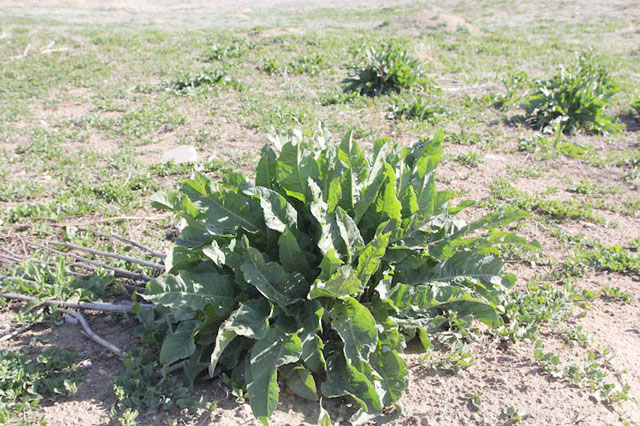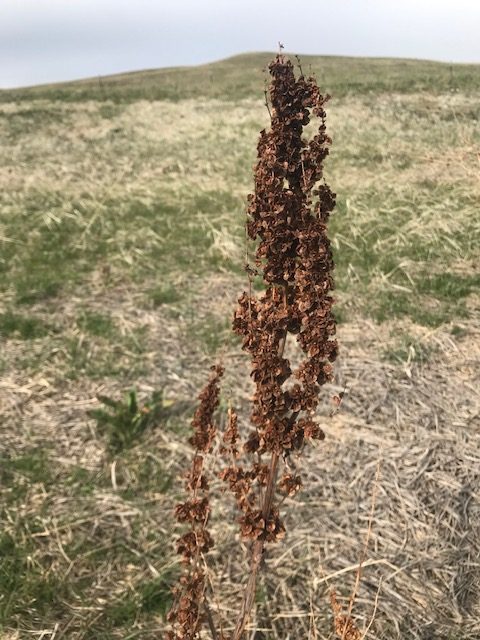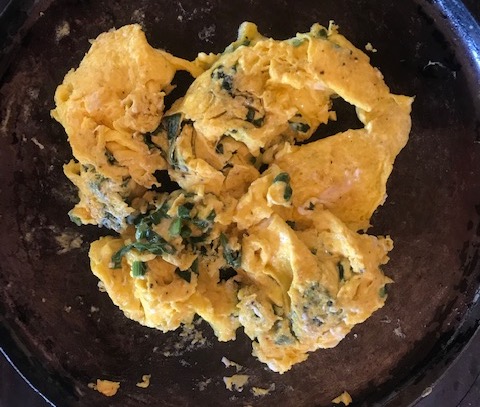
Eat what your animals eat – curly dock

I cooked up some eggs with curly dock this morning. I wanted to share why I’m feeling grateful this spring for the plant, also called yellow dock or Rumex crispus, that many consider it a weed. It is such a welcome fresh green to break up the anonymous kale, cabbage and bagged spinach of winter, that I think it is worth celebrating.
My family and I have long noticed how our goats race with snorts and tail-wagging to devour these greens in the spring, and more recently we have discovered it as a springtime favorite of ours as well — when fencing around a nice patch of it, we usually bring a bag out with us to harvest, happy to know that our goats will be getting some, too.
Often you can find it in a pasture by its tall rust colored seed stalks from last year, standing like a flag for those who know to come search nearby for these clusters of nutrient packed greens.

The sturdy green leaves grow out from a central stem, with older, tougher leaves on the outside, more tender ones to the inside, but the central leaf that is unfurling is protected by a slimy (delicious) gel. In general, the younger and smaller leaves are milder, more tender and better for eating raw, chopped up and added in small amount to other greens in a salad, or cooked; the larger leaves (in the full swing of summer the leaves can get over a foot long!) tend to be tougher and slightly more bitter – they are better in the springtime when they are not so big, chopped up and added to a stir-fry, rather than cooked all by themselves. Unless I’m in a big patch of dock, I try to avoid picking the central leaf/stalk so that the plant can continue to produce more leaves and eventually send up its flowering stalk.
If you slightly sauté the leaves, you’ll find they are delightfully mild, slightly lemony and reminiscent of cooked spinach. Like it’s relative sorrel, that lemony taste indicates dock’s high vitamin C content. Herbalists prize the bright yellow roots for helping many ailments of the digestive system, and especially for helping with anemia, as it has a high amount of bioavailable iron – you can bet the leaves are packed with iron as well!

I hope this helps you find some dock growing nearby, and that you may share in our gratitude for its good nourishment, as well as the joy and surprise in finding another friend out on the pasture. If any of you know more about this plant, especially its role in an ecosystem, I would love to hear about it. Please leave a comment below!
Sorry, the comment form is closed at this time.





Brandy Dalton
I LOVE THIS POST!
When we ranched in New Zealand I followed a lady who made posts like this and put on foraging classes. I learned SO much.
Please keep writing and educating us!
Thanks!
ULF EGIL ULLRING
Thank you! Have to try this. You can use the seeds from the brown stalks too. Gather dry seeds from the stalks and crush them. Mix 50-50 with wheat flour. Add a pinch of salt, and then water enough for a dough. Make flat pieces and bake crackers on a hot stone, plate or skillet. Very good nutty flavour! Vary ad libitum with other ingredients.
Another tip: Tom Elpel’s book “Botany in a day” – a treasure chest of knowledge. Tom lives in Montana.